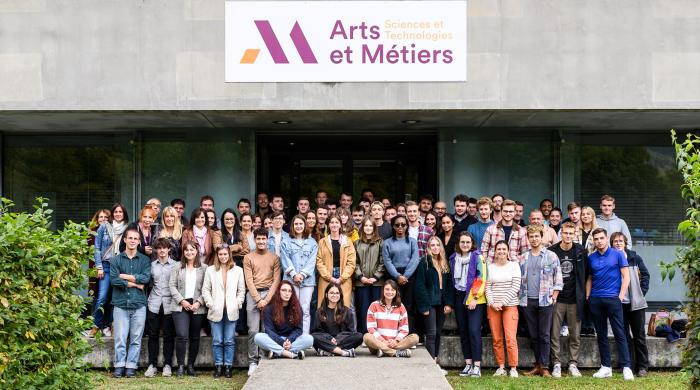Arts et Métiers was in charge of determining piezo locations and of the high-level software interface with CTEC hardware ensuring damage monitoring. We participated in the implementation at TU Delft of the trial campaign.
An intense two year test campaign on aerospace composite structures at the Aerospace Structures & Materials Laboratory of Aerospace Engineering Faculty of the TU Delft (NL) and at the Department of Mechanical Engineering & Aeronautics of University of Patras (GR) has resulted in a unique Structural Health Monitoring (SHM) Database. This knowledge bank provides the aviation industry and research communities data to not only diagnose the current state of the structure real-time, but to additionally predict the future state of the structure of aircraft by using artificial intelligence models. This can support aircraft maintenance engineers to detect, locate and assess the severity of damage of composite aerospace structures that is often not apparent at the surface and requires a lot of time to detect through manual inspections. This is the first database – worldwide - that is publicly available for that purpose. The SHM Data is now available at: https://dataverse.nl/dataverse/ReMAP_H2020_SHM_data_repository
Bumpy landings and human decisions
”Nowadays a pilot decides whether, for instance, a bumpy landing is reason to check the aircraft structure. This is a human based decision. We want to move from this dependency of human factor alone”, says project-leader Dimitrios Zarouchas (Faculty of Aerospace Engineering). “With this knowledge bank we want to demonstrate how by using state of the art sensing technologies and AI-based algorithms we can further enhance this decision-making process of maintenance. This database is not just for one specific aircraft. Every stakeholder in the aviation industry should have the possibility to learn from this database and adapt its outcome to their needs. Operators can use it as a benchmark and compare their performance when it comes to aircraft maintenance. Aircraft manufacturers can use this database to improve their design. That is why we keep our models and test campaigns as generic as possible.”
438.000 test cycles and still counting
The SHM data has been collected using five different sensing technologies. Zarouchas: ”By far this number is unique as commercial initiatives use only one sensing technology that is applicable for only one type of aircraft and thus is company dependent. We collected our data from hundreds of thousands test cycles on generic composite structures simulating realistic flight conditions and abnormal situations, such as bumpy landings and low energy impacts. In the coming period the database will be further populated with data from tests at more representative structural levels. We envision that the research community in collaboration with aviation industry will use this database and design predictive models and share these in return. More accurate models and more reliable predictions of the condition of the aircraft structures could help to shift towards smarter and more efficient, so called condition-based maintenance. ”
Contribution to Green Aviation
The introduction of reliable SHM technologies that can continuously monitor the existence of minor damages, will allow to design with higher design allowables thanks to a more reliable detection of damage. Mid-term design impact on structural components is expected to result in a 3 to 7% reduction of weight. On the long term the adoption of more efficient aerostructures design is estimated in a weight reduction of 10-20%. This weight reduction will result in 105 tons less fuel and 350 tons CO2-reduction for an aircraft flying 700 flights per year.
Part of a four year European research project: ReMAP
This research is part of an European project called ReMAP (Real-time Condition-based Maintenance for Adaptive Aircraft Maintenance Planning) that started in June 2018 and will continue until May 2022. ReMAP’s aim is to make the maintenance of aircraft fleets smarter and more efficient. For the first time, the use of health diagnostics and prognostics from dissimilar aircraft systems and structures will be used to create real-time adaptive maintenance plans. A fleet level approach will be followed, since the potential of CBM can only be achieved by monitoring the health of all aircraft in a fleet, managing maintenance resources and operational needs. In Europe alone, the potential savings on aircraft maintenance can amount to 700 million euros per year. This project has received funding from the European Union’s Horizon 2020 research and innovation program. The Structure Health Management-research will be tested on lab-scale. The diagnostics and prognostics on aircraft systems and components ánd the real-time adaptive maintenance planningtool will be tested in a real life demonstration at KLM.
ReMAP partners
For this SHM research composite panels are designed by Embraer (PT) and manufactured by Optimal Solutions (PT). The sensors are provided by Cedrat Technologies (FR) and Smartec SA (CH) and are very carefully placed on these panels by scientifically based criteria from the University of Patras (GR). École National Supérieure d’Arts et Métiers (FR) developed the data acquisition software.
Partners involved in diagnostics and prognostics on aircraft systems and components which culminates into an Integrated Fleet Health Management Tool are ATOS (SP), UTRC (IE), ONERA (FR), University of Coimbra (PT), TU Delft and KLM.
Photo credits: TU Delft



